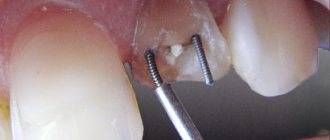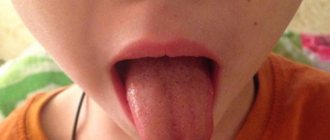When do baby teeth appear?
The first teeth begin to appear closer to 6 months, but deviations in one direction or another are possible (there are cases when a child is born with teeth).
Procedure and approximate dates (the child’s age in months is indicated in brackets):
- lower (6-9) and upper (7-10) incisors;
- lateral upper (9-12) and lower (9-12) incisors;
- first upper (12-18) and lower (13-19) molars;
- upper (16-20) and lower (17-22) fangs (popularly called “eye teeth”);
- second lower (20-33) and upper (24-36) molars.
In total, by the age of three, the baby has a set of 20 closely spaced teeth.
Preventive measures
The baby's relatives must do everything to prevent a dangerous situation: the little one should not choke on the crown bone. How to do it? The child needs to be explained that the unsteady unit requires observation. Mom will often look at the tooth. It will definitely fall out, so you need to be prepared for it. The baby should not be given solid food for some time. Relatives should help the little one get through a difficult moment by caring for him.
It is important to follow recommendations for the prevention of caries in children. The mother should think about this during pregnancy. There should be no deficiency of fluoride and calcium in a woman’s body. After the birth of a toddler, you need to carefully follow hygiene standards, do not lick nipples and spoons. The organization of a balanced diet is of particular importance. Include kefir, milk, and baby yoghurts in your diet. To absorb calcium, vitamin D is needed. A child can get it from fish dishes and sunbathing.
It is necessary to limit the consumption of sweets, because harmful streptococci feed on sugars. During their life, they release acid that destroys enamel. Fresh vegetables and fruits are healthy. A reliable remedy against caries is baby paste and a toothbrush. As soon as the milk chewing organs appear, they need to be cleaned. Teach your child hygiene skills from an early age. Take your child to the dentist twice a year. The doctor will detect the disease in the early stages and prescribe therapy.
When does the change from dairy to permanent begin?
An adult has from 28 to 32 molars in the oral cavity. This figure may vary depending on the presence of so-called “wisdom teeth”.
In order for such an amount to fit in a child’s mouth, jaw growth begins from the age of five, and the spaces between the baby teeth increase. At the same time, the eruption of the molars begins with the loosening and loss of the molars, usually occurring in the same order as their appearance.
It is important to know: there are several points that parents should be aware of in order not to panic and not worry their child:
- the change of teeth between the ages of 5 and 10 years is a normal process that needs to be observed, but not interfered with;
- intervention may be required if the baby tooth is tightly seated (usually fangs), and the molar is already growing below. In this case, the growth trajectory may change, which in the future will lead to physiological and aesthetic inconveniences. Regular visits to the pediatric dentist will help avoid this problem;
- Replacing lost teeth with permanent ones does not require special diets or restrictions, because this is a gradual process and not a sudden phenomenon.
What to do with a lost baby tooth?
The answer is here. And in this article you can learn about fluoridation of teeth in children.
Why can baby teeth fall out unnoticed?
A 5-year-old child already has a full set of primary dentitions and is already beginning to loosen for prolapse. It would seem that the most unpleasant period has passed, the child no longer suffers from the unpleasant sensations that bother him during teething. But this may not be the easiest time for parents.
When baby crowns fall out, there is a risk that they will be accidentally swallowed. This happens because they begin to loosen. When applying pressure while chewing, there is a high probability that it will fall out and enter the stomach along with food. Moreover, even the child does not immediately notice that he has parted with his incisor.
During the period of change in bite, the crowns become very loose and are ready to fall out at any moment. That is, it is physiologically designed in such a way that it should not cause unpleasant sensations. For this reason, the baby does not notice the “loss”.
However, after the prolapse, you can see the hole from which the blood comes. It's not much, but it's noticeable. The hole requires more attention than a swallowed piece of crown.
Is there a danger in swallowing a tooth?
Children may refuse to pull loose teeth out of fear of pain. Nevertheless, they themselves show interest, constantly touching it with their tongue or hands.
There are cases of swallowing baby teeth, especially during meals. There is no reason to worry about this unless the child is choking.
What is swallowed will simply pass through the digestive tract and leave the host naturally. Particularly suspicious relatives can monitor this process by examining the offspring’s stool, but this recommendation is not mandatory.
From this video you will learn what happens if you swallow a tooth:
First aid
First aid is needed not to remove the tooth from the stomach, this cannot even be done, but to stop the bleeding and protect the socket from infection.
When a child swallows a piece of tooth, it will not cause discomfort or damage the organs. Moreover, a thin clove can be overcooked, but not always. The lost crown will successfully leave the body naturally without consequences.
Attention! There will be a risk if the parents begin to somehow remove the clove, for example, causing a gag reflex. This should not be done, because a piece of the tooth can get into the respiratory tract, damaging it.
Interestingly, a digested clove will become an additional source of calcium, that is, it will take part in the formation of a healthy skeleton. It is better to look at this situation from this angle, because there are no risks, and parental panic will only upset the child.
The situation is much more dangerous when a tooth falls out not while eating, but when there is a risk of inhalation. In this case, there will be clear signs of aspiration (a foreign body entering the respiratory tract). In this case, you need to call an ambulance.
So, what to do when a child swallows a lost tooth:
- do not show the child that something terrible has happened and do not panic;
- feed well;
- examine the hole to see if there is a blood clot in it;
- prepare a weak disinfectant solution for washing the well;
- apply a cotton swab slightly moistened with an alcohol-free antiseptic to the wound;
- remove the cotton wool after 15 minutes.
Good to know!
After swallowing a piece of crown, it is better to feed the baby enveloping foods. Porridge with milk, fruits and vegetables, and mashed potatoes are well suited for this purpose.
Tooth loss: causes and methods of restoration
The method of restoration will be determined by why the tooth fell out.
Advanced caries or pulpitis. With insufficient hygiene and lack of treatment for caries, it turns into pulpitis, and hard tissues begin to collapse. The process is very painful, accompanied by inflammation, the crown gradually cracks, and the infection spreads to the pulp and root. When a tooth falls out, it feels like a relief: it will finally stop hurting. In practice this is almost always not the case:
- inflammation can affect periodontal tissue. Without treatment, the infection will continue to spread, affect surrounding tissues, and provoke new complications;
- Teeth destroyed by pulpitis do not always fall out completely. Collapse of the crown walls may occur, leaving the infected root in place.
Even if the pain goes away after a loss, this does not mean that the problem is solved. The absence of pain indicates the death of the nerve. It is accompanied by necrosis, which provokes the appearance of new foci of inflammation.
What to do: You need to see a doctor as soon as possible. It is better not to wait until the crown is completely destroyed. If it remains above the gingival margin, there is a chance to preserve the living root and perform restoration or prosthetics. If the crown is completely destroyed, the doctor will remove the remaining root and begin preparation for prosthetics. When the crown is destroyed by caries or pulpitis, diagnostics is needed: the dentist must evaluate the condition of the root, periodontal tissues, and nerves in order to prevent the development of inflammation and complications.
Periodontitis or periodontal disease. This is gum disease. They have different courses, but the result is the same: teeth become loose and fall out. However, they can be quite healthy. The problem is the condition of the gum tissue. Long before the loss, symptoms should appear: loosening, drooping of the gingival margin (tooth enamel is exposed), possible bleeding of the gums, itching, discomfort, and pain. If a tooth has already fallen out due to gum disease, the doctor must evaluate the condition of the gum and bone tissue in order to offer the patient implantation or prosthetics.
What to do: it is better to consult a dentist when the first symptoms appear (the gums begin to bleed, its edges droop, itching appears, a reaction to temperature stimuli). If the patient has not done this, more complex treatment will be needed. The periodontist must restore the normal state of the gums (relieve inflammation, normalize blood circulation, etc.). If such treatment is possible, implantation is performed next. If not, a removable or bridge prosthesis is installed.
Injury. A lost tooth may be healthy and your gums may be in normal condition. The recovery tactics will be determined by how exactly the crown was damaged and whether the root was preserved.
What to do: You need to urgently consult a dentist. If possible, a fallen crown should be preserved. If a patient breaks and swallows a tooth (or loses it or throws it away), prosthetics will be needed to restore the dentition. If a tooth falls out completely and is preserved, there is a chance that it can be returned to its place (it is placed in the hole and secured with a splint).
If a tooth is completely knocked out, you need to:
- stop bleeding in the hole (press with a sterile swab);
- quickly find the tooth, do not touch the root, grab only the crown;
- rinse it carefully in water (do not wipe it, do not wash it under running water);
- put in place (in the hole), fix (bite through gauze or tampon);
- contact your dentist immediately.
Healing is possible if the tooth can be returned to its place (put in the hole) half an hour (before the nerve dies). If you can’t do this yourself, it is placed in whole milk (not water) and delivered to the dentist. It is impossible to leave the tooth dry (not in milk), the nerve will die in a few minutes.
Prosthetics, implantation, restoration.
Leave a request, we will call you back within 5 minutes
+7
Dentist appointment
Now let's move on to the question of the aesthetics of a smile. Even if the crown has not completely fallen off, it still needs to be replaced with a new one. We advise you to contact a trusted dentist to ensure that the prosthesis is securely fixed. For maximum reliability, we recommend giving preference to higher quality materials, such as ceramics or cermets. Plastic is a budget option, but the service life and reliability of fastening leave much to be desired.
To prevent such situations, we recommend visiting the dentist every six months. In this case, there is a chance that the doctor will promptly notice the unreliable fixation of the artificial tooth and prevent further problems. Also pay attention to the service life of the crown. If it is designed for 5 years, after the period has passed, you need to see a specialist and take an impression to make a new prosthesis.
Why did the crown fall off?
Most often, the process of swallowing is invisible; a person understands this only after finishing the meal and the absence of an artificial tooth. Usually the cause is the consumption of solid foods, for example, the process of chewing tough meat. If the problem occurs shortly after dental prosthetics, the reason is poor-quality installation and unreliable fixation of the crown. The second option is that the crown fell off after a long time. Most likely, the prosthesis has expired, so the artificial material could not withstand the next load.
If a tooth is broken
In case of injury, partial destruction of the crown is possible: it breaks off, but the root remains in place. If the patient breaks a crown, you need to:
- if possible, save the fragment (perhaps the doctor will be able to use it during restoration);
- contact a dentist for examination and consultation;
- take diagnostic images to assess the condition of the root and make sure that it has not been injured;
- perform recovery as quickly as possible.
Recovery is performed in several ways. In case of severe destruction, an artificial crown is installed (possible provided that the root is not damaged and the chip or fracture line passes above the gum). If half of the crown is broken or the chip is small, restoration with a composite is possible (using a pin for strengthening if the damage is large, or without it if the chip is superficial). An urgent visit to the dentist is necessary because the pulp may be exposed and vulnerable to infections. Even if the treatment requires the installation of an artificial crown, at the first appointment the doctor will install a temporary crown or filling, perform antiseptic treatment, and other procedures to prevent inflammation and infection.
Do I need to restore a broken or lost tooth?
Dentists at the DentoSpas clinic do not recommend leaving gaps in the dentition. It is better to plan and perform restoration, implantation or prosthetics as quickly as possible. Without treatment, bone tissue atrophy will begin, the load on adjacent crowns will increase, and the chewing load will begin to be distributed unevenly. This will lead to displacement of neighboring teeth and may cause their loss. If left untreated, a broken or chipped crown will continue to deteriorate and repair will become impossible. With advanced caries, periodontal disease, and periodontitis after tooth loss, the disease does not go away on its own; it continues to develop until complete edentia.
Complications of caries in children -
As we said above, in children under 3 years of age, newly appeared caries can turn into pulpitis (inflammation of the nerve in the tooth) in just 2-3 months, which is also due to the too small thickness of enamel and dentin.
The resulting pulpitis can have either an acute or chronic course. The acute course of pulpitis in primary teeth is characterized by the occurrence of spontaneous paroxysmal pain, especially at night and in the evening. The pain is usually provoked by hot or cold food, and after eliminating the irritant it can last from 15 minutes to several hours. In the chronic course of pulpitis of primary teeth, pain symptoms may either be completely absent, or pain may occur during meals (due to irritation of the receptors in the area of the bottom of the carious cavity by the food lump). This form of pulpitis can be very difficult to distinguish from average caries, which often leads to medical errors. Mistaking pulpitis for average caries, the doctor traditionally treats it with silvering or filling, which inevitably leads to the development of periodontitis (24stoma.ru).
But in the absence of treatment, pulpitis in any case sooner or later transforms into periodontitis (purulent inflammation at the apex of the root). The following symptoms are characteristic of periodontitis in primary teeth: 1) an abscess periodically appears on the gum in the form of a lump filled with pus, 2) fistulas with purulent discharge periodically open in the projection of the root of the diseased tooth on the gum. What purulent inflammation looks like during periodontitis (Fig. 15-16).
The occurrence of fistulas and purulent lumps on the gums is an absolute indication for tooth extraction (regardless of how much time is left before its physiological change). The fact is that purulent inflammation at the apex of the root of a baby tooth can most likely cause inflammation of the germ of a permanent tooth, which is located only 1-2 mm from the tops of the roots of a baby tooth. In addition, bacteria and toxins will constantly enter the blood, leading to deterioration of immunity and the development of a number of chronic diseases (for example, diseases of the ENT organs, bronchial asthma, allergies, etc.).
You can read about what needs to be done if your child has a fistula or purulent abscess on his gum in the article at the link above.
HOW MUCH TOOTHPASTE DOES MY CHILD HAVE TO SWALLOW FOR THIS TO BE A PROBLEM?
With scary new toothpaste labels (indicating the fluoride concentration in “some” units - ppm, mg), many parents are wondering what to do when they catch their child eating toothpaste straight from the tube or in the toothpaste bath. smeared all over the counter. This makes it difficult for parents to estimate the amount swallowed. Considering the relatively low fluoride content in most brands (e.g. President Dady, Elmex Kinder, Lacalut baby, Edel white, Splat junior, Emoform actiflour kids, Colgate bubble gum, ROCS baby, etc.), it is quite difficult for a child to take a lethal dose of fluoride at home . If you do know approximately how much fluoride toothpaste a child has eaten, the following table shows how much would need to be swallowed in order to see a doctor (data from the Georgian Poisons Center)
If your teeth are loose under braces
This often happens in teenagers and not only in the case of braces, but also during bite correction with a vestibular plate. On the one hand, this is a normal phenomenon, since the essence of orthodontic treatment is to move the tooth, which means making it mobile for some time. Such a tooth may begin to loosen.
On the other hand, the degree of mobility should be assessed by a doctor. If your teeth are too loose, this can lead to their loss. You may need to pause the bite correction or undergo additional therapy.
So, loose teeth in children are most often a normal phenomenon associated with the change from a primary bite to a permanent one. However, it is better to remove them in the dentist's chair so as not to infect the socket and not to scare the child, especially if this is the first time. Extraction of a baby tooth is quick and not painful, so it is the best reason to introduce your child to the dentist and prevent the formation of a fear of dental treatment.










